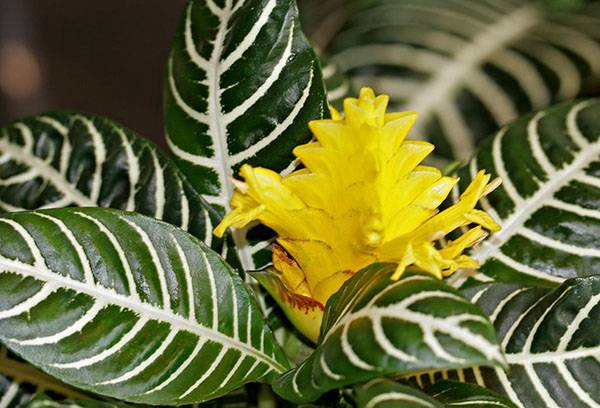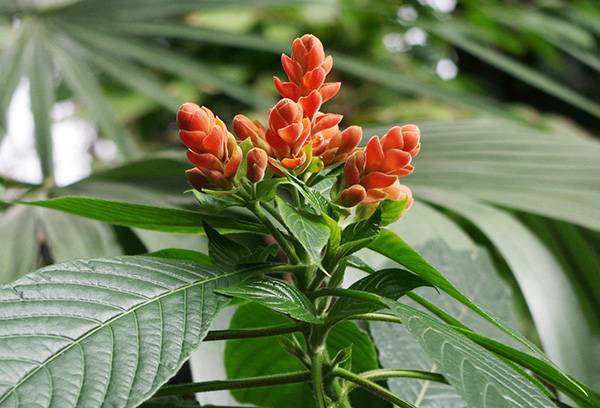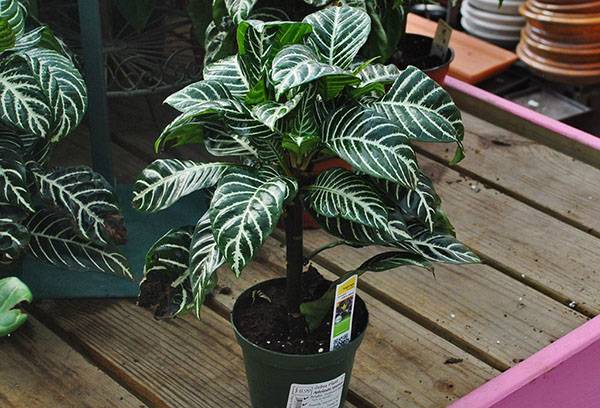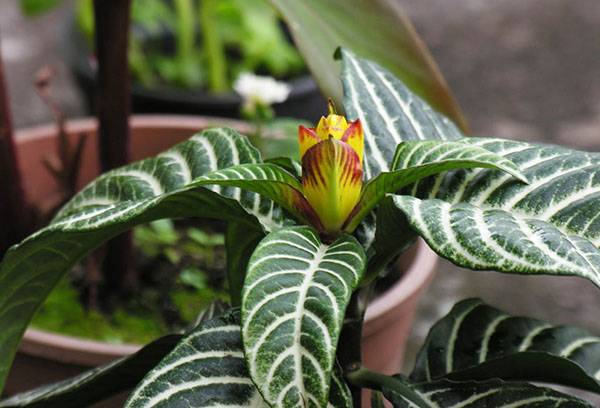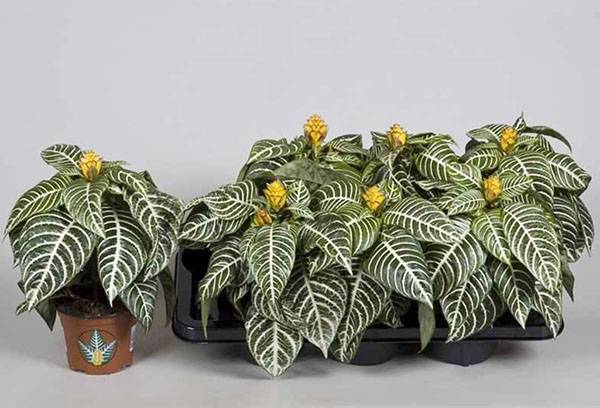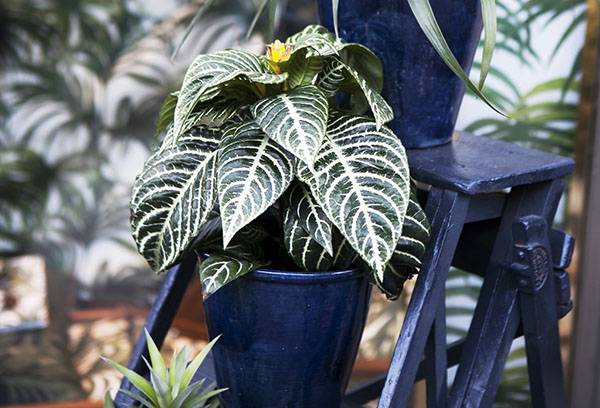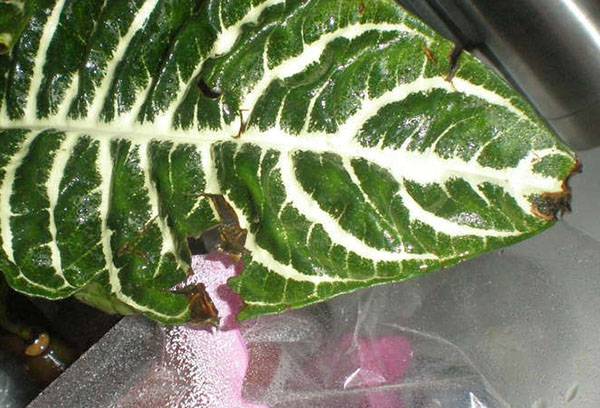How to care for afelandra at home?
Content:
The most beautiful indoor plant of afelander strikes with dense saturated greens and an unusual pattern of leaves. Blooming in early autumn, when most home crops have already bloomed, it throws spike-shaped yellow, red or coral inflorescences. For the opportunity to admire their beauty, an exotic flower requires a careful attitude and does not tolerate close proximity with other representatives of the flora. Caring for afelandra at home is a rather difficult task, if the lighting standards or irrigation are not observed, it can quickly wither, discard leaves, and even die.
Plant description
The homeland of afelander is Central America, so it is not surprising that the plant always needs a lot of light and moisture. Growing at home, the flower lives no more than three years and reaches a height of 50 cm.
Florists appreciate the afelander for beautiful, opposite leaves. Bright stripes stand out against a bright green background of a rigid sheet plate along the central and lateral veins, forming an intricate ornament. Some species have faded spots between the veins that make the flower even more decorative.
In early autumn, the plant throws yellow, golden or pink flowers, forming spike-shaped inflorescences with quadrangular bracts. Attractive exotic ears, reaching a height of 20 cm, delight the eye for 6-8 weeks.
More than 200 species of this plant grow in nature, but only a few varieties survive at home, one of which is protruding aphelander. The flower is very finicky, but if it is provided with proper everyday care, it is incredibly decorative and grows fast.
Plant species
There are several varieties of this houseplant - they differ slightly in the color of leaves and flowers, but equally require careful care.
- Aphelandra aurantiaca (orange) - has oblong ovoid leaves, reaching a length of 25 cm, and inflorescences of a bright orange color.
- Aphelandra squarrosa (squarossa) - differs by pale veins on leaf blades and light yellow inflorescences.
- Aphelandra tetragona (comb) - it surprises with large inflorescences of red color in the form of ridges and a saturated green color of foliage.
- Aphelandra sinclairiana (Panama) - may have pink, orange and even lilac flowers.
In nature, the plant grows in the form of a bush or tall grass and blooms in the summer. Home Afelander blooms depending on the conditions created.
How to care for afelandra
Each houseplant requires certain growing conditions, light and humidity, soil composition. Afelander is no exception - caring for it at home is a rather time-consuming process.
Light and warm
For a southern plant, heat is very important. Many indoor flowers easily tolerate a decrease in air temperature in the winter to + 16 ° C, but not afelander. For the growth and flowering of this crop, a temperature of at least + 22 ° C is needed.
In addition to heat, the flower cannot do without good lighting, so the windows facing west or east are considered the best place to place the pot with the plant.If the afelander is placed on a window sill facing south, the plant will have enough sun and heat, but you will have to constantly take care to protect the foliage from the harmful effects of direct ultraviolet rays.
Particular attention should be paid to the neighborhood with other domestic plants.
Important!
Afelandra does not tolerate neighborhood with other flowers, so it is better to put the pot with this plant separately.
Watering
Afelandra care includes regular watering. The earth in the pot should always be slightly moist, and for irrigation it is better to use warm soft water, such as rain or boiled. You should not water the plant with cold water from the tap, as this can turn into big trouble for him.
In addition, the flower requires spraying and humidification. In a dry summer, when the air in the room becomes warm and dry, you can put the pot in a pan with pebbles, flooded with water.
Transplant and top dressing
Soil with a neutral or weak balance of acidity is well suited for the growth and development of the plant. The mixture can be purchased in a specialty store or made with your own hands, mixing turf soil, humus, peat and sand in equal proportions. The soil should be light and loose, pass air well and not retain moisture. When landing, it is necessary to provide drainage.
Important!
The plant must be replanted every spring, as it grows very quickly and loses its decorative effect. This is another difficulty in caring for Afelandra.
The flower intensively grows green mass, so you should constantly enrich the soil with nutrients. Top dressing is carried out at least twice a month and universal fertilizers are used for flowering indoor plants.
Propaganda reproduction
There are several ways to propagate this exotic flower, but in any case, for the process to succeed, you need heat (from +22 to + 25 ° C) and increased humidity. How to grow an afelander, understood the author of the site purityis.decorexpro.com/en/.
- Seeds
The seeds used to propagate the afelander are harvested in early March and immediately planted in a soil mixture made from turf and sand. To speed up the process, the seed pot must be properly watered, placed in a plastic bag and put in a warm place, on the battery or underfloor heating. After the bores appear, they are dived into separate pots. Flowering can be expected as early as the year of planting.
- Cuttings.
It is very simple to spread the afelander with cuttings that are cut in January or May. For cutting, take annual shoots and cut the tops so that a stalk 15 cm long with two leaves is obtained. Future planting material is placed in a pre-prepared soil substrate, watered and covered with polyethylene. Usually, 15-20 days are enough for rooting cuttings, during which you need to regularly recline the polyethylene protection and ventilate the plantings. After the cuttings take root, they are planted in a permanent place in the pots.
- Foliage.
The technology of plant propagation by leaf exactly matches the rules for growing cuttings, only as a planting material is a leaf cut together with a axillary bud from a healthy shoot.
Important!
When cultivating afelander with leaves, one should not take planting material from flowering shoots.
Pruning after flowering
By purchasing this exotic indoor plant, not all gardeners know how to care for afelandra after flowering, and are very upset when, along with the withering of the inflorescences, the whole appearance of the flower begins to change.
The fact is that during flowering, all the forces of the plant go to the formation of inflorescences. After this work is completed and the flowers fade, the green mass begins to increase. In this case, the lower leaves fall, the stems are exposed and lengthened. If urgent measures are not taken, the flower will quickly turn into an untidy bush, as it is in nature.
To cope with this problem will help regular and proper pruning. Experts advise trimming afelander in early spring, removing two-thirds of the main trunk and leaving only a few buds in the lower part of the plant for future growth. This procedure will preserve the compactness of the flower and increase the number of inflorescences.
In addition to cardinal pruning, pinching the growing shoots will help to give the flower the desired shape.
Common problems
There are a number of problems that are the same for all varieties of this moody plant. Caring for afelandra, one must carefully monitor the condition and color of the leaves so as not to miss the moment of the disease and death of the flower.
- Leaves fall. Afelandra, growing to a certain height, discards the lower leaves. This is quite natural and is due to the peculiarities of the vegetation of the domestic plant, which in the past grew in the wild. After all, the Afelandra, growing in the forests of America among tall thick grass, as soon as it begins to rise above its neighbors, also drops the lower leaves. Pruning will allow the plant to return to its previous form.
Another thing is when the leaves fall at any time of the year, regardless of the flowering period. In this case, the cause should be sought in uncomfortable environmental conditions: dry air, low temperature, and too bright sunlight. To correct the situation, it is necessary to transfer the flower to a ventilated place, water and sprinkle.
- The flower fades. If the plant is in a draft for a long time, then the leaves weaken, begin to dry at the ends and gradually fade. This can lead to the death of the whole plant, so the aphelander needs to be urgently moved to a protected place.
- Does not bloom. Often, flower growers notice that a favorite plant suddenly lost its attractive decorative appearance, new leaves appear small and not so bright, flowering is short or absent altogether. This is due to a lack of nutrients. It is necessary to feed the flower with useful microelements, and in especially advanced cases, cut and transplant into new soil.
- Spots on the leaves. Brown spots on the leaves of Afelandra indicate too bright illumination of the room and an excess of direct sunlight. If there is no way to rearrange the plant to another place, it must be shadowed.
- The base of the stem rots. When the flower is in a humid and cold room for a long time, it will begin to rot. The plant should be urgently moved to a warm place and not watered until the soil dries out and the flower is restored.
- The brown color of the leaves. In addition to all the conditions listed above, the afelander will not be able to grow and bloom in a gassed or smoky room. This capricious representative of the flora needs fresh air, otherwise the leaves from green will turn into dark brown.
Knowing what changes in appearance the flower signals about its deplorable state, it will be possible in time to provide the pet with all possible assistance and save it from withering.
With proper care, the exotic home-grown Afelander plant will long delight you with bright inflorescences of an unusual shape and decorative foliage, calming the nervous system, creating an excellent mood and filling life with harmony and beauty.
We advise you to read the article: plants that clean the air in the apartment
